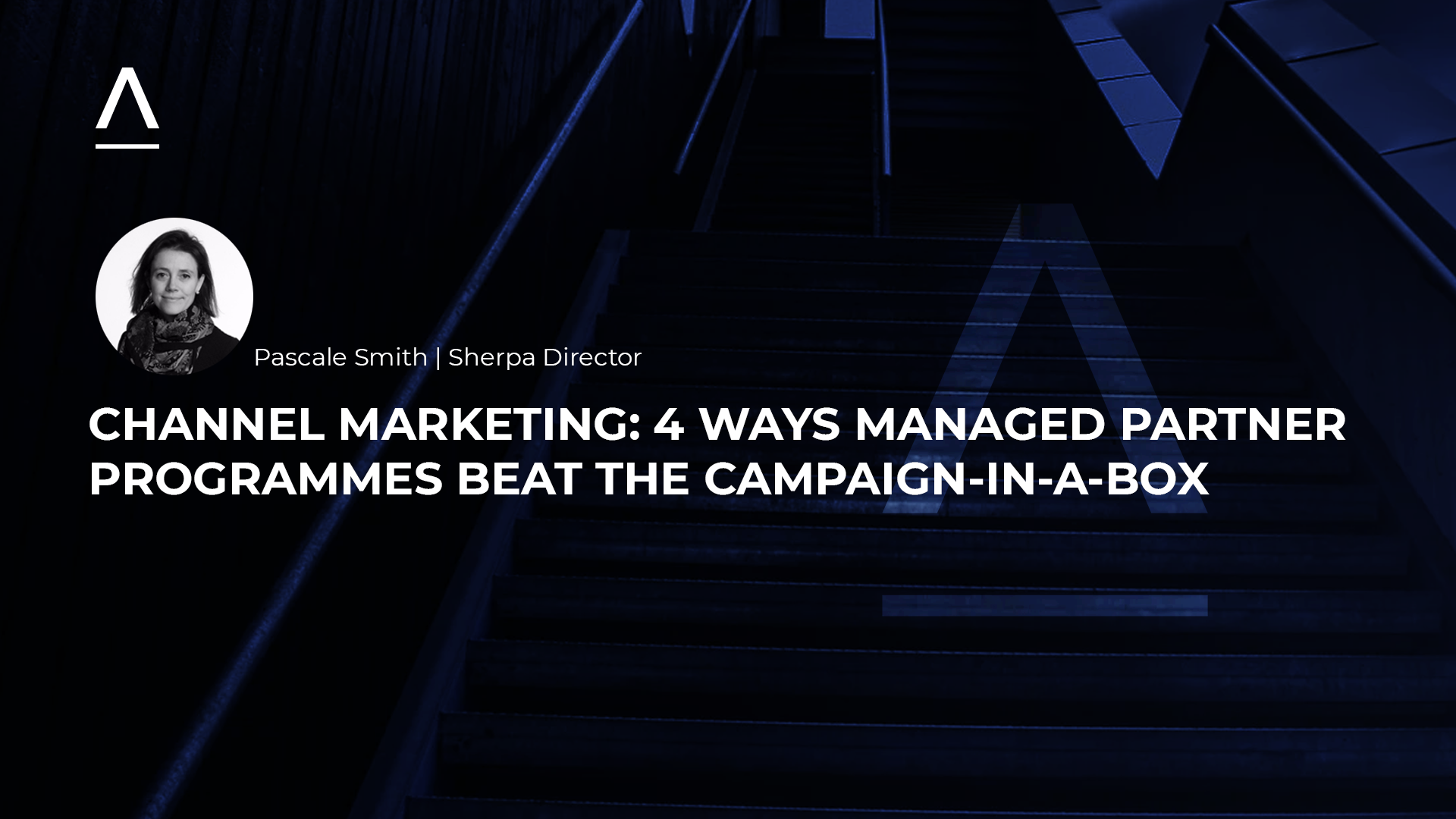On-demand webinar: The Partner Marketing Funnel: Introducing the 4 Why's
Partner marketing isn’t just about generating leads. It’s about moving opportunities through the funnel with clarity and purpose. Yet for many...

Following the success and feedback of our Clock Tower dinner in April, the Sherpa team hosted guests for our second roundtable dinner. Our guests included large, global tech vendors in the networking, open-source software, call centre and industrial IoT spaces. We also welcomed forward-thinking resellers and independent software vendors and marketing services suppliers.
The topic of dinner was centred around Channel Marketing and how we see changes being applied to the way channel marketing operates to benefit all parties. We started by posing quite a large question to the table and have refined the discussion in to key takeaways:
This is a theme which often comes up when we ask about challenges in channel marketing and it does seem to underpin a lot of frustrations in vendor, distributor and reseller alike. There is a long term issue here. Visibility is a consistent stumbling block across partners, vendors, distributors, and between internal departments - primarily sales and marketing. Visibility around planning, product, marketing and strategy needs to improve. So long as there are blind spots, then metrics become useless, communication becomes fragmented and processes do not yield the optimum revenue.
For Vendors, being able to differentiate themselves from competitors is getting increasingly difficult. There is an abundance of choice when it comes to products and service levels and it is getting harder and harder for Vendors to stand out. Data causes an issue in itself, not just because of GDPR limitations, but because many companies are targeting the same individuals and have access to the same data amplifying the level of competition. So what is the answer?
Having a defined value proposition is key and being able to demonstrate the commercial value of a new solution or tech stack has become ever more important. Utilising the relationship they have with their partners is one way for Vendors to implement new technology streams as Resellers have limited to no barrier in this area. So, in order to cut through the competition do Vendors need to be more disruptive? Absolutely. If you are a disruptor, now is the time!
Companies who have experienced success in the USA have attempted to bring their channel model to EMEA and have faced problems. But why? What it really comes down to is that they operate completely differently. US-centric vendors tend not to want to tackle regional differences and have a one-strategy to rule them all as it makes tracking, measurement and platform decisions easier and more streamlined. However acting as ‘Master Agents’ can lose opportunities and gives rise to lack engagement in regions. However, even though many companies are not tackling regional differences in channel environments, they are not resting on their laurels...2019 has seen more serious movement in the channel than in previous years. The channel is certainly being taken more seriously and although the processes, dynamics and challenges have not changed there are more companies who have specialised channel teams. This was highlighted at the 2019 channel meet up.
GDPR came into effect in May 2018 and left many companies clawing their way to GDPR compliance. But has GDPR had any knock on effects on companies? Well it depends on how companies reacted to the legislation. Many businesses panicked and deleted large chunks of data without fully getting to grips with the legality behind retaining the records on their CRM. As such they are now experiencing a negative impact on their sales funnel and are looking to plug this depletion by purchasing SQLs from specific data companies.
This propensity for lead purchase doesn’t stop at vendors. Many data companies are seeing an increased interest from Resellers as they are given chunks of MDF and they are looking to purchase leads.
The conversation around sales and marketing dominated much of the evening. But this tackled numerous intricacies of sales and marketing misalignment. Firstly, the question around terminology was raised. The language around leads is actually extremely restrictive and as such we have to ask if marketing actually putting restrictions on ourselves by over classifying? There is a requirement to classify in order to aid measurement and analytics, but potentially this absolute classification and linear process leads to issues with lead nurture, Sales are able to identify opportunities more readily than marketing - even if they are not already in the marketing flow...so in actuality does marketing work for sales?
However, misalignment doesn’t just happened between teams, there is a general lack of alignment between lead expectations and the expectation of salespeople. More lead nurture needs to happen to ensure prospects are truly qualified by the time they reach the point of sale and all of their queries and pain points have been addressed.
So how do we bring sales and marketing closer when some businesses’ sales and marketing teams don’t even speak and have totally different metrics? How do you make marketing revenue more accountable? Shared goals and sales enablement are key. Many companies would benefit from a hybrid model where employees span sales and marketing. As well as this, cultural discipline is needed. An example was shared where some vendors will not pay out if sales records are not fully completed, highlighting the absolute importance of end to end metrics. Success is entirely dependent on both teams having complete visibility of the sales and marketing funnel.
From a reseller perspective, leads aren’t always the most valuable currency. The priorities from their perspective are partner enablement, Insight into the Buyer journey and content with a shared narrative. Once partners understand the shared narrative, it makes the sales and marketing process more streamlined and collaborative. With the above point of marketing working for sales with regards to lead nurture, there is also a requirement for sales to feed back in to marketing with lead narrative. Sales are receiving valuable information from prospects each time they pick up the phone, and this information is integral in feeding the story from the bottom of the funnel, upwards.
Sticking with resellers and sales and marketing alignment, we discussed whether ABM is actually the right thing for them? Well, most resellers know their market inside out and can, therefore, market to them effectively without needing to know about intent. Resellers work in specialised verticals and therefore know their market intrinsically. They have therefore been doing ABM in one form or another for quite some time, However, in order to make it better, they need access to resources to make it better and the MarTech to be able to fully interpret intent.
End to end solutions don't work anymore and so the need for ISVs and a more complex channel is very much upon us. Channel-based alliances and strategic relationships make solutions more complex with 3-way relationships ever more common and needed to deliver customer solutions. Partners and ISVs are certainly driving this change.
Access to data in these relationships is critical and so the visibility issue plays out even more acutely in the ISV scenario. ISVs are very niche and operate in very specific verticals, thus service levels and education from vendors is hugely important to them.
We had a fantastic evening at the St Pancras Clock Tower, and it was a pleasure hearing the thoughts of some of the leaders in our field.The Clock Tower series is run by the Sherpa team and focuses on Channel Transformation. To register your interest for further events, please click here or join the Tech Marketing Leader’s Forum and stay part of the conversation.
.jpeg)
Partner marketing isn’t just about generating leads. It’s about moving opportunities through the funnel with clarity and purpose. Yet for many...

Partner marketing is entering a new era.

Partner marketing isn’t just evolving, it’s accelerating. With buying committees now stretching to 20+ decision-makers, AI reshaping how we work, and...
-1.png)
It was once again a pleasure to host the State of Channel 2023 Panel Discussion and thank you to all who joined the session live. Hosted by Jay McBain

It was a pleasure to host and see so many dial in to Sherpa’s State of Channel 2022 Panel discussion featuring: Host: Jay McBain, Forrester Research ...

The demands made of channel Partner marketing are significant: it needs to scale, demonstrate ROI, generate revenue (often within a quarter), reflect...